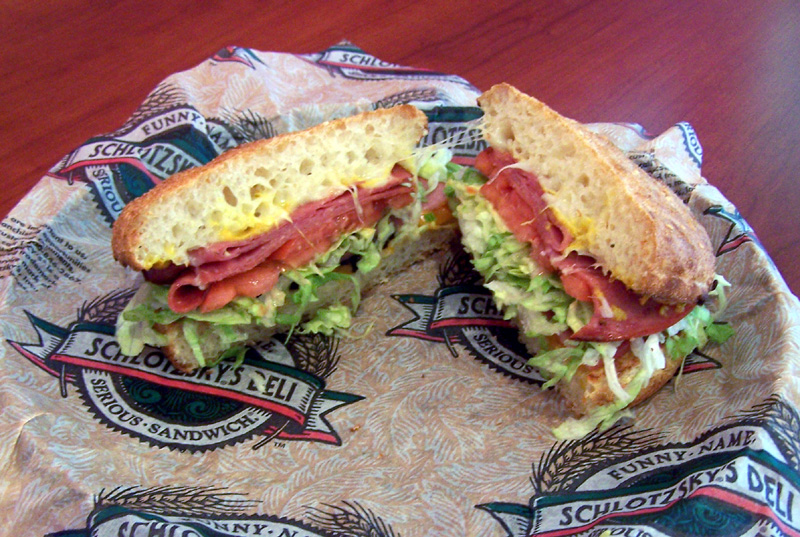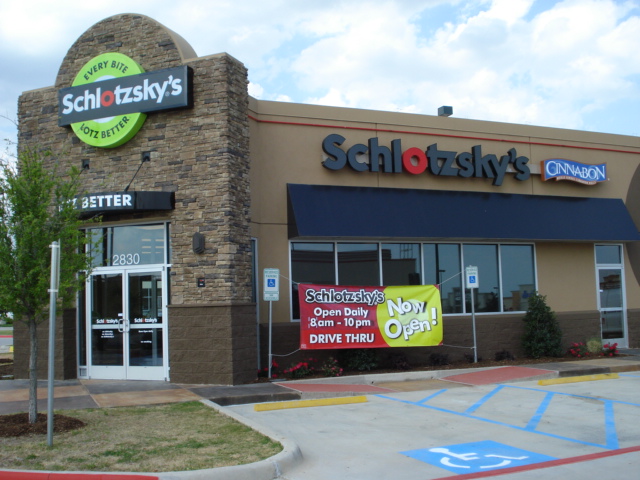Schlotzsky’s began in 1971 as a single sandwich shop on Austin’s South Congress Avenue. You’ll recognize their signature sourdough bread, smoked meats, and three-cheese blend—famously even served on Frisbees in the early days. Their quirky name and fresh ingredients helped them expand to roughly 100 locations within about a decade. Though they faced financial challenges in the 2000s, their journey from local Austin favorite to international chain reveals the power of distinctive flavors and smart franchising.
Image: Schlotzskys at English Wikipedia, Euless Texas Schlotzsky, CC BY-SA 3.0
A $2.95 Sandwich That Started It All
While many culinary empires begin with complex business plans and massive investments, Schlotzsky’s remarkable journey started with a single sandwich in 1971 on South Congress Avenue in Austin, Texas. The Original® sandwich—priced as an affordable option—was the company’s sole offering and quickly captured Austin’s attention.
This 8-inch creation featured a signature flavor profile built on freshly baked sourdough, a combination of smoked ham, Genoa and cotto salami, three melted cheeses, and fresh vegetables. The distinctive taste became an instant customer-loyalty driver, setting Schlotzsky’s apart from typical sandwich chains. For their 47th anniversary celebration, Schlotzsky’s offered their iconic sandwich for $1.99 at participating locations.
In a playful touch that added to its charm, these early sandwiches were even served on Frisbees, creating a memorable experience that helped transform a simple sandwich into the foundation of a restaurant empire. Much like the iconic establishments of Dallas’ Main Street District, Schlotzsky’s represents how a single business concept can evolve into a vibrant commercial success story.
The Story Behind the Quirky Name
This unconventional branding strategy proved brilliant. In a landscape dominated by burger chains, the quirky, memorable name stood out, especially among University of Texas students. The name’s distinctiveness mirrored Austin’s own embrace of individuality.
Though lacking a literal meaning, “Schlotzsky’s” became synonymous with The Original and reflected the founders’ entrepreneurial spirit. Their willingness to embrace the unusual transformed a whimsical word into an iconic brand that continues to intrigue customers today. The company’s immediate success in Austin led to rapid expansion, reaching about 100 locations within roughly ten years of opening their first store.
Schlotzsky’s growth parallels other successful businesses like Dell Technologies, which found prosperity after relocating to nearby Round Rock in a strategic business development move.
From One Sandwich to Full Menu Evolution

Simplicity marked Schlotzsky’s humble beginnings—a single 8-inch, muffuletta-inspired creation known as “The Original” that launched the entire enterprise. But you’ll hardly recognize today’s expansive offerings compared to those early days.
The 1990s brought a wave of menu diversification that transformed the six-sandwich lineup into a full-fledged bakery-café experience. New breads, pizzas, wraps, and paninis appeared alongside gourmet soups and freshly tossed salads. This menu evolution mirrors what many successful food franchises experienced, including Gatti’s Pizza, which transformed from “The Pizza Place” to a beloved chain with signature recipes that have been carefully guarded for decades.
Their Fresh-from-Scratch® approach, first exported to Canada in 1988, reinforced their quality-ingredient focus while broadening their appeal. Later innovations included shareables, beer and wine for social dining, and proprietary potato chips that extended the brand beyond sandwiches. After going public in 1995, the company expanded into a dozen or so international markets across the Middle East and beyond.
What began as a single-sandwich shop cleverly evolved to meet changing consumer tastes while maintaining its authentic roots.
Austin Roots: How Local Culture Shaped the Brand
Behind every successful chain lies a birthplace that shapes its DNA, and for Schlotzsky’s, that foundation is unmistakably Austin, Texas. When Don and Dolores Dissman opened their tiny South Congress shop in 1971, they embodied the city’s entrepreneurial spirit with their quirky-named, muffuletta-inspired sandwich.
What made Schlotzsky’s quintessentially Austin:
-
Their community-focused marketing relied on authentic word-of-mouth rather than polished campaigns
-
The brand’s “hole-in-the-wall” aesthetic matched Austin’s appreciation for genuine, independent businesses
-
Their modest pricing respected the city’s working-class and student population
-
Their emphasis on fresh-baked bread anticipated Austin’s emerging foodie culture before local-sourcing initiatives became trendy
This Austin identity remained intact even as franchising began in 1977, expanding the Texas staple nationwide. The humble shop that started with one sandwich called The Original would eventually grow to 750+ stores by its peak in 2001.
The Franchise Revolution of the Late 1970s
While Schlotzsky’s had captured Austin’s heart with its distinctive round sandwiches, the company’s true transformation began in the mid-1970s when the founders ventured into franchising. Their timing couldn’t have been better—the franchise model quickly propelled them from a single Austin location to around 100 restaurants by 1981, primarily targeting college markets throughout the Southeast. The first official franchised location opened in Bryan/College Station in 1977, marking the beginning of their interstate expansion.
What made Schlotzsky’s different? Their eight-inch round Original stood out in a crowded market, driving customer loyalty across new territories. This rapid expansion caught the attention of Austin investors John and Jeff Wooley, who purchased the chain in 1981 for less than $3 million. Under their leadership, Schlotzsky’s implemented operational innovations that cut prep times while maintaining the quality that kept customers coming back.
Going Public: Schlotzsky’s Journey to Wall Street
December 15, 1995 marked a pivotal milestone as the sandwich chain made its debut on NASDAQ under the fitting ticker symbol BUNZ. The initial public offering was priced around $10 per share, generating roughly $20 million in capital to fuel the company’s ambitious expansion plans.
With hundreds of locations and rising sales, the IPO glow faded as franchisee financing strains surfaced. You might be surprised how quickly their Wall Street dream unraveled:
-
Franchisees defaulted on company-financed locations
-
Losses mounted by the early 2000s
-
The Wooley brothers exited leadership in 2004
-
NASDAQ delisting preceded acquisition by FOCUS Brands in 2006
This financial downfall was a stark contrast to the company’s humble beginnings as a single sandwich shop founded by Don and Dolores Dissman in Austin back in 1971.
Navigating Growth Challenges in the Early 2000s
The flush of IPO success quickly gave way to sobering realities as Schlotzsky’s entered the new millennium. Operational instability became evident as mounting debt—including costly development-rights transactions—pushed the once-thriving chain toward crisis. By 2004, the company filed for Chapter 11 protection before being reorganized and later acquired.
Strategic shortcomings compounded these problems. While competitors embraced emerging health trends, Schlotzsky’s was slower to adapt its menu to low-carb, lower-fat preferences. Leadership turnover and a board with limited quick-service expertise hampered decision-making during this pivotal period. Remodels briefly boosted sales but added to capital burdens as competition intensified and traffic slid. The company’s turnkey financing for franchise build-outs proved risky when many franchisees struggled to meet obligations.
The Secret Behind the Signature Sourdough
View this post on Instagram
Many sandwich shops claim unique bread, but Schlotzsky’s sourdough has remained the cornerstone of their success through both prosperity and turmoil. The bread’s distinctive texture and tang come from a true sourdough process—a living starter and long, temperature-controlled fermentation—rather than shortcuts.
You’ll recognize this iconic bread by:
-
A gentle tang from natural fermentation that brightens the flavors
-
The satisfying cornmeal-dusted bottom that adds textural contrast
-
The golden-brown top, often brushed for a soft sheen and aroma
-
A pillowy interior that cradles fillings without becoming soggy
Careful yeast-starter maintenance and extended proofing are what truly set this bread apart from competitors.
Building a Legacy: Record-Breaking Events and Brand Identity
While the sourdough recipe fueled Schlotzsky’s flavor appeal, what transformed this modest Austin sandwich shop into a national phenomenon was its business trajectory and distinctive brand identity. By 2001, you could find Schlotzsky’s in 759 locations nationwide, generating hundreds of millions in annual systemwide sales—a testament to their operational efficiency during rapid expansion.
The brand’s evolution from a single-sandwich concept to a diverse menu of specialty pizzas, wraps, and salads exemplified brand diversification while maintaining its Austin roots. Their marketing positioned Schlotzsky’s as a premium alternative to conventional fast food, emphasizing quality over speed. The company’s memorable slogans, including the recent “It’s a mouthful.” launched in 2021, helped cement their unique identity in consumers’ minds.
Despite financial challenges in the early 2000s, their community-focused strategy and curious name created a lasting cultural impact that transcended typical fast-casual dining.


